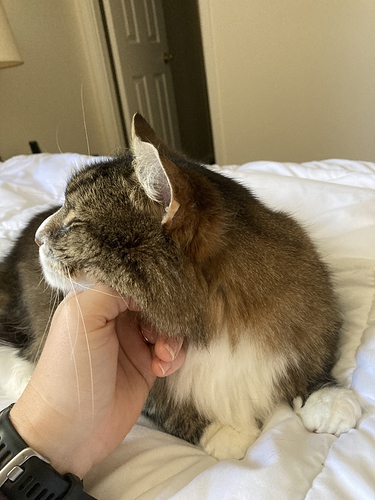Bartholomew, 9 or so, healthy Maine Coon mix. Prozac helps him to be a happy, well-adjusted fellow, and it also depresses his appetite. Some days he eats all his food and some days he doesn’t. I’d like to put another half pound on him. His weight is not ideal but it isn’t unhealthy, so he’s not a candidate for prescription medications. The catch: it can’t be a high volume of food (he’s a grazer- he won’t eat it all in one sitting and his brother will take it,) and he doesn’t like salmon oil. Yes, I know. He eats salmon just fine, especially if it has Old Bay, but he doesn’t want a nice salmon oil top-dressed on his food. I think it’s a texture thing.
Currently eating:
approx. 1/2 cup Orijen Adult dry food- available for grazing throughout the day
heaping spoonful of Weruva Mack and Jack wet food (the spoonful of sugar that helps the medicine go down)- there are limits to what he’ll eat in a sitting, so although I can increase this, he’ll leave it when he’s done, and then his brother will eat it.
Greenies, lysine treats, and Dasuquin (he’s not arthritic, he gets it because if he didn’t have his own he would eat his brother’s. The fastest way to get one of these cats to eat a thing they’re ambivalent about is to pretend the thing is for the other cat.)
He’s not a huge fan of things that come in a gel formulation. I’m willing to try them if you tell me that every cat in the world has licked it down and asked for more.
Ideas I’m looking at: bonito flakes, Lexelium powder, salmon oil soft chew. Although the you-don’t-need-this Dasuquin should be taking care of any early stage arthritis he has, I’d love to get him on some omega-3’s as he’s getting into middle age.
Experiences with these or other ideas?



